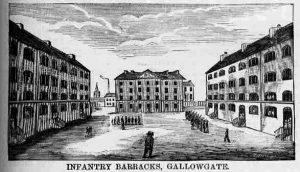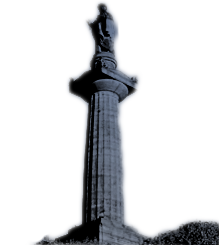Welcome to the second edition of Grave Matters, the newsletter for those indexing the Burial Registers of the Glasgow Necropolis and other interested Friends.
Many years ago when I started work on the Necropolis’s Burial Registers curiosity made me draw up a graph of annual burials in the cemetery. Below is a new version which illustrates a number of interesting points. The most striking fact is how short a time the Necropolis flourished. By 1866, when burials peaked at 1548 that year, almost half the burials to take place in the Necropolis’s 160 years lifetime had already occurred. The decline in numbers after 1866 was very steep and by 1875 burials had dropped below 400 per annum and never recovered. Sixty years later burials were below 200 per annum and by 1950 they were below 100 per annum. In the last year for which I have figures (1995) there were only 9.

Necropolis Burials
One of the most interesting pieces of information found in the early Burial Registers is the cause of death of the deceased person. There was no obligation to record it but it is found in the Burial Registers until the end of 1854, ceasing when civil registration of births, marriages and deaths started, in Scotland, on 1st January 1855. The causes of death given in the Burial Registers have not been certified by medical practitioners unlike those on modern death certificates and some of them may seem rather odd to us. Sometimes a symptom like ‘fever’ is given as the cause of death.

Infantry Barracks Gallowgate
Many of the common infectious diseases are to be found, cholera, measles, hooping cough (note the spelling), scarlet fever, typhus, typhus fever, and many, but by no means all, victims are children. Between 26th January and 22nd March 1834 there was an outbreak of measles in the married quarters of the Infantry Barracks in the Gallowgate during which ten children died. The ages of the children ranged from 6 months to 13 years most being under five. The first death was that of Martha Clark, daughter of Sergeant James Clark of the 82nd Regiment of Foot. In the next fortnight two of Martha’s sisters died and one brother, all from measles. All four were buried in the Single Grave Delta 1 which was in use at that time. Later in February Private James Rynalds, also 82nd Foot, and his wife lost two daughters in the outbreak.
Many deaths were ascribed to hydrocephalus (also known as water in the head). The vast majority of deaths occur in infants under 5 years of age which suggests hydrocephalus had been present since birth and was, in fact, the result of complications during birth. On the other hand the small number of adults diagnosed with hydrocephalus may have suffered some sort of head injury. Childbirth was a dangerous time for mothers and children as is shown by the number of times puerperal fever, childbed or childbirth occurs in the records; the youngest mother was 19 and the oldest 41. Sometimes the child survived and sometimes not – many stillbirths and premature births are recorded. Alexander Grosart and his wife suffered three still births in 1872, 1873 and 1874 respectively; James Anderson, baker and his wife suffered two still births in February and September 1837 and

there are other examples of couples losing multiple pregnancies. Premature birth was particularly dangerous for twins; David Law and his wife lost twin daughters at 2 days in 1846 and Archibald Watson and his wife’s twin daughters only survived for one and two days respectively in 1837. The Watson twins are named as Jane and Elizabeth but the Law daughters are unnamed in the burial register. I wonder whether this implies Jane and Elizabeth had been hurriedly baptised before their premature deaths and the Law girls had not.
In Grave Matters No 1 I mentioned that one of the burials from 1842 added to the database was that of a still born son of Mr Schwabe in the Jews’ Burial Ground (Alpha 1). It turned out that Mr M H Schwabe had already buried three children in the preceding years (1836-1838). On further investigation a Schwabe stone was discovered in compartment Epsilon. Unfortunately this stone is very badly eroded and the transcribers from the Glasgow & West of Scotland FHS were unable to obtain any information from it. It may be that they were working from a photograph of the stone and it would probably be useful to examine the actual stone to see if anything can be made out. The whole stone seems to have been inscribed including the base.

Schwabe Lair
Checking the index to the burial registers the records of three burials in Epsilon lair 84 were found: Rudolph H Schwabe, 31, buried 26 Jan 1860, Hermann L Schwabe, 74, buried 26 June 1874 and Auguste B Schwabe, 83, buried 18 June 1883. As Schwabe is such an uncommon name in Glasgow it proved easy to trace in the Glasgow Post Office directories, the census schedules, newspapers and the records of births, marriages and deaths. H L Schwabe and his wife and children were easily identified but M H Schwabe was more of a problem. There was a firm of merchants in Glasgow called M H Schwabe & Gobert of which H L Schwabe was a partner. Legal notices relating to the partnership identify M H Schwabe as Marcus Hertz Schwabe, a pillar of the Jewish community in Hamburg where he died in 1862 at nearly 100 years old. I have not found any evidence to show he resided in Glasgow in the late 1830s and fathered the children buried in the Jews’ Burial Ground when he would have been in his 70s. I think it more likely that the children who died between 1836 and 1842 were children of H L Schwabe and his wife Auguste but some confusion arose between the initials of the father and the name of his firm when the entries were made in the burial registers. When Mrs Schwabe died in 1883 the following was published in the Glasgow Herald:
THE Late Mrs H. L. SCHWABE — The grave closed yesterday in our Necropolis over the mortal remains of a lady who some years ago occupied a prominent position in this city on account of her benevolence and of the interest she took in all that was good and noble. Mrs H. L. Schwabe about fifty years ago, was one of the first German ladies who left her native country with her husband to settle in Glasgow. By her high character, refined manners, and agreeable presence, she soon won the esteem of all who became acquainted with her, and her home circle was soon increased by men and women of intellect and position. Her house became the centre to which her countrymen were attracted, and an introduction to which was a voucher for their respectability and intelligence, but it was also open for any one who required advice or a helping band for any good purpose. She gave where she could, but not only with her hands, her heart was in her work, and no fatigue was too much for her in carrying out her good intentions. She was an active promoter of several educational and benevolent institutions. She took an active interest in the Queen’s College for the Education of Young Ladies, and, assisted by the late Mr Robt. Dalglish, Mr Walter Crum, and other leading citizens, she established a public nursery, likely the first of its kind in Glasgow, where little children could be left under proper care while their mothers were employed in warehouses and works. After the death of her much-beloved husband, who had seconded her in her noble efforts, she removed to Edinburgh, where her daughters follow the good example set by their parents. The eldest is the wife of Lord MacLaren and the younger one one of the secretaries of the Society for the Higher Education of Women. Mrs Schwabe will long be remembered by all who knew her as one who not only aspired to higher aims, but also inspired others with the same feeling. The funeral service was conducted by the Rev. Dr Crosskey, of Birmingham.
Glasgow Herald (Glasgow, Scotland), Tuesday, June 19, 1883; Issue 146.
One of the indexers is working on the later burial registers from the 1950s onwards and there are some interesting points of contrast with the earlier registers. Firstly, as mentioned above, the number of burials each year is very much reduced even though new lairs are still being sold in the 1960s. Secondly the vast majority of those buried are aged over 50 and so far no children or teenagers have been buried, and thirdly those between the ages of 20 and 50 are made up almost entirely of the victims of the Cheapside and Kilbirnie Street fires in 1960 and 1972 respectively. The type of information given in the modern registers is somewhat different from the earlier ones. It is nearly always impossible to tell whether a woman is married or not as ‘Mrs’ is not used as a prefix and husbands are not identified as happened in the nineteenth century. Another loss is that no occupations are given for the men. The major change is that addresses are now recorded and I recognised quite a few from the Springburn/Townhead area – Glebe Street, Grafton Square, John Knox Street, Edgefauld Road, Bedlay Street, Onslow Drive are just a few. There are addresses too from outside the city like Bearsden, Clarkston, Newton Mearns and further afield to Ayr, Largs, Helensburgh and even Bexhill-on-Sea and Bournemouth.
Anyone who would like to help with this indexing project is very welcome to join us by contacting me at research@glasgownecropolis.org









